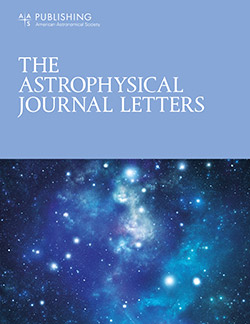Pavo: Discovery of a Star-forming Dwarf Galaxy Just Outside the Local Group*
IF 8.8
1区 物理与天体物理
Q1 ASTRONOMY & ASTROPHYSICS
引用次数: 0
Abstract
Abstract We report the discovery of Pavo, a faint ( M V = −10.0), star-forming, irregular, and extremely isolated dwarf galaxy at D ≈ 2 Mpc. Pavo was identified in Dark Energy Camera Legacy Survey imaging via a novel approach that combines low surface brightness galaxy search algorithms and machine-learning candidate classifications. Follow-up imaging with the Inamori-Magellan Areal Camera and Spectrograph on the 6.5 m Magellan Baade telescope revealed a color–magnitude diagram (CMD) with an old stellar population, in addition to the young population that dominates the integrated light, and a tip of the red giant branch distance estimate ofPavo:在本星系群外发现一个正在形成恒星的矮星系*
摘要:我们报道了在D≈2 Mpc上发现了一个微弱的(M V =−10.0),恒星形成,不规则,极其孤立的矮星系Pavo。Pavo是在暗能量相机遗产调查成像中通过一种结合低表面亮度星系搜索算法和机器学习候选分类的新方法确定的。在6.5米麦哲伦Baade望远镜上的Inamori-Magellan面相机和摄谱仪的后续成像显示了一个彩色星等图(CMD),其中有一个年老的恒星群,以及占主导地位的年轻恒星群,红巨星分支距离估计为1.99−0.22 + 0.20 Mpc。CMD中蓝色的恒星群与最年轻的恒星形成时间不晚于150万年前一致。我们还用SOAR望远镜成像没有探测到H α辐射,这表明我们可能正在目睹帕沃星形成的暂时低谷。我们估计Pavo的总恒星质量为log M * / M⊙= 5.6±0.2,并根据HIPASS调查测量了其H气体质量的上限为1.0 × 10.6 M⊙。考虑到这些特性,Pavo最接近的类似物是狮子座P (D = 1.6 Mpc),它是之前已知的唯一一个在这个质量范围内孤立的、形成恒星的局域体积矮星系。然而,帕沃似乎更加孤立,没有其他已知的星系居住在600公里以外。随着调查和搜索技术的不断改进,我们预计会在本地群体之外发现一大批类似的物体。
本文章由计算机程序翻译,如有差异,请以英文原文为准。
求助全文
约1分钟内获得全文
求助全文
来源期刊

Astrophysical Journal Letters
ASTRONOMY & ASTROPHYSICS-
CiteScore
14.10
自引率
6.30%
发文量
513
审稿时长
2-3 weeks
期刊介绍:
The Astrophysical Journal Letters (ApJL) is widely regarded as the foremost journal for swiftly disseminating groundbreaking astronomical research. It focuses on concise reports that highlight pivotal advancements in the field of astrophysics. By prioritizing timeliness and the generation of immediate interest among researchers, ApJL showcases articles featuring novel discoveries and critical findings that have a profound effect on the scientific community. Moreover, ApJL ensures that published articles are comprehensive in their scope, presenting context that can be readily comprehensible to scientists who may not possess expertise in the specific disciplines covered.
 求助内容:
求助内容: 应助结果提醒方式:
应助结果提醒方式:


